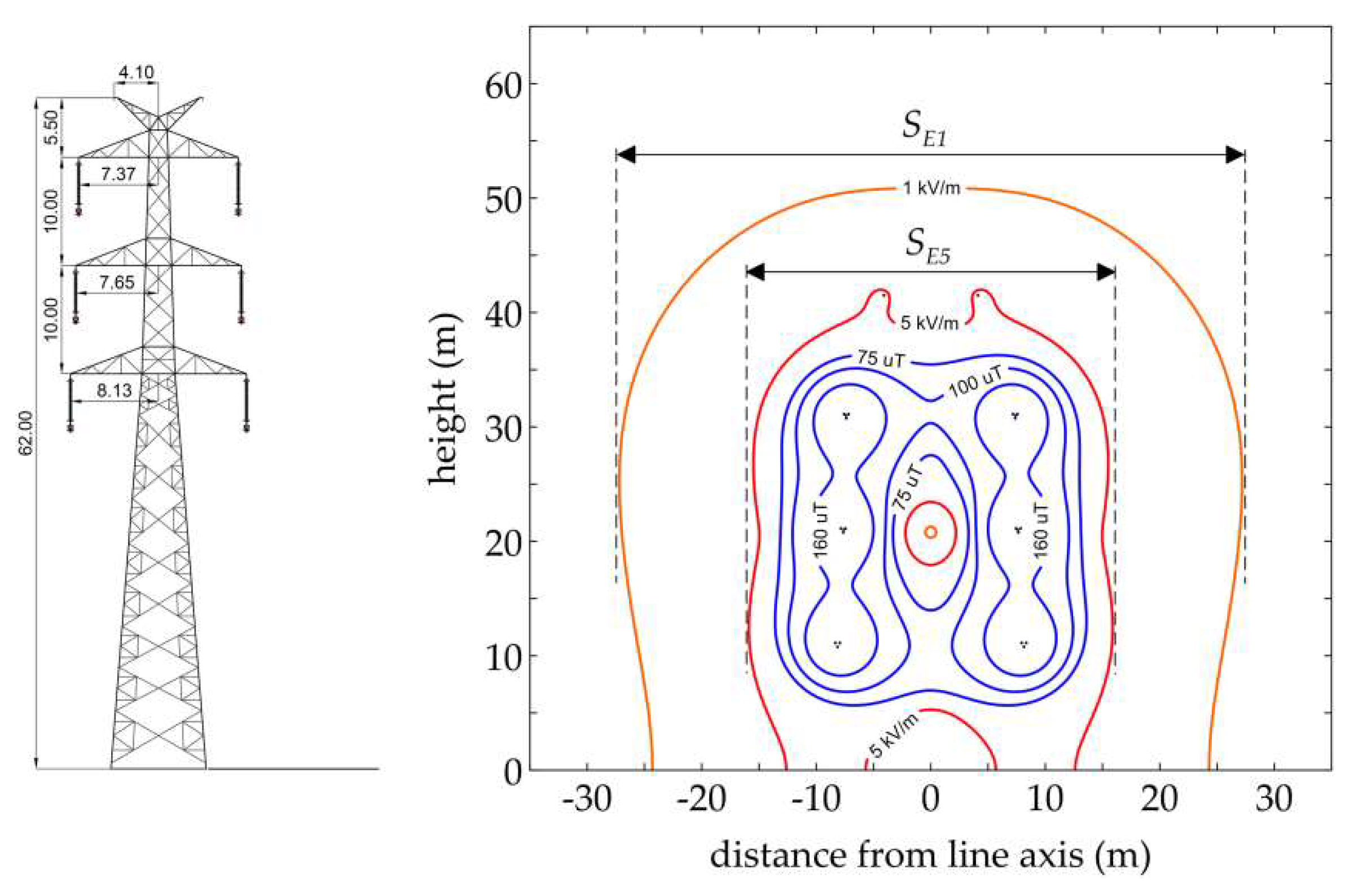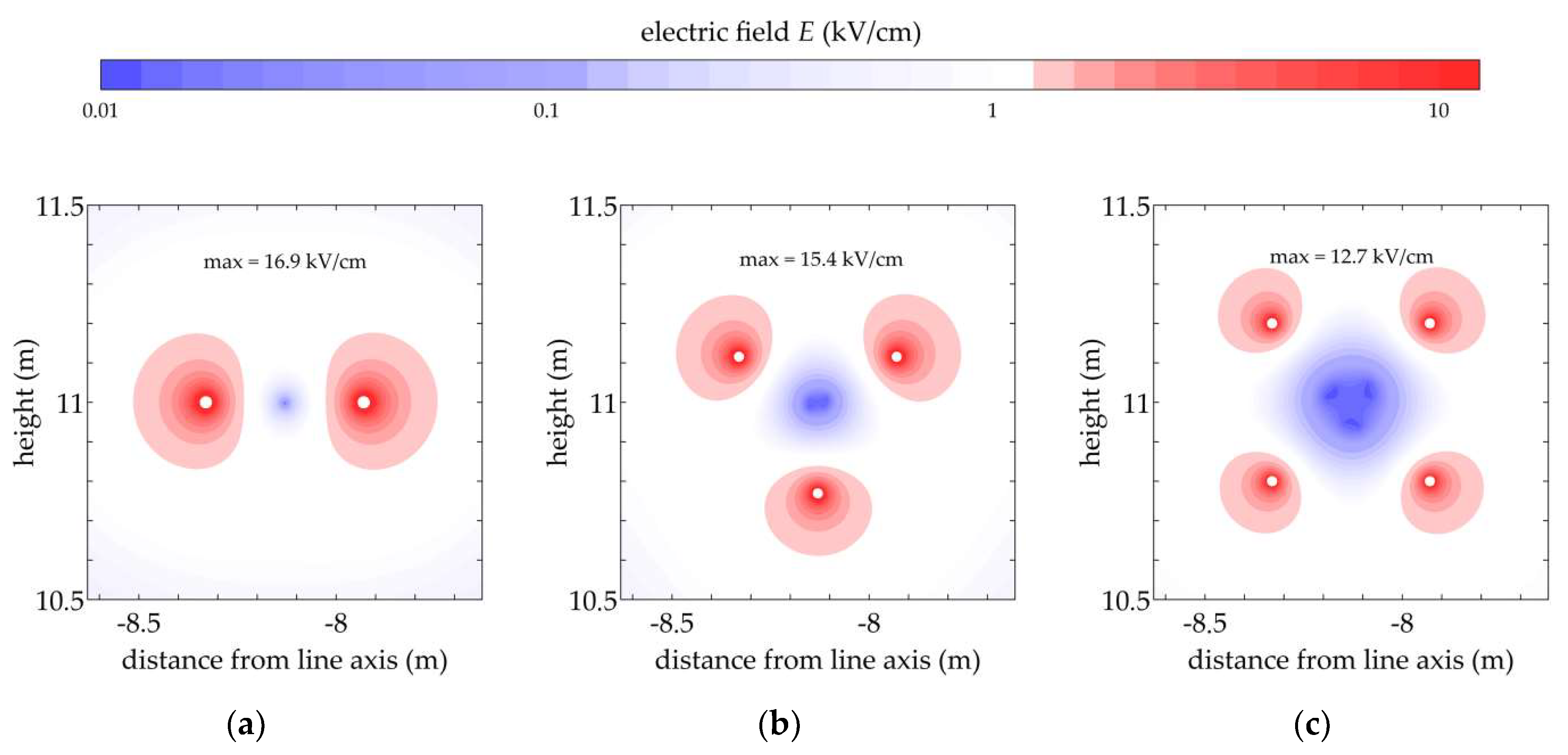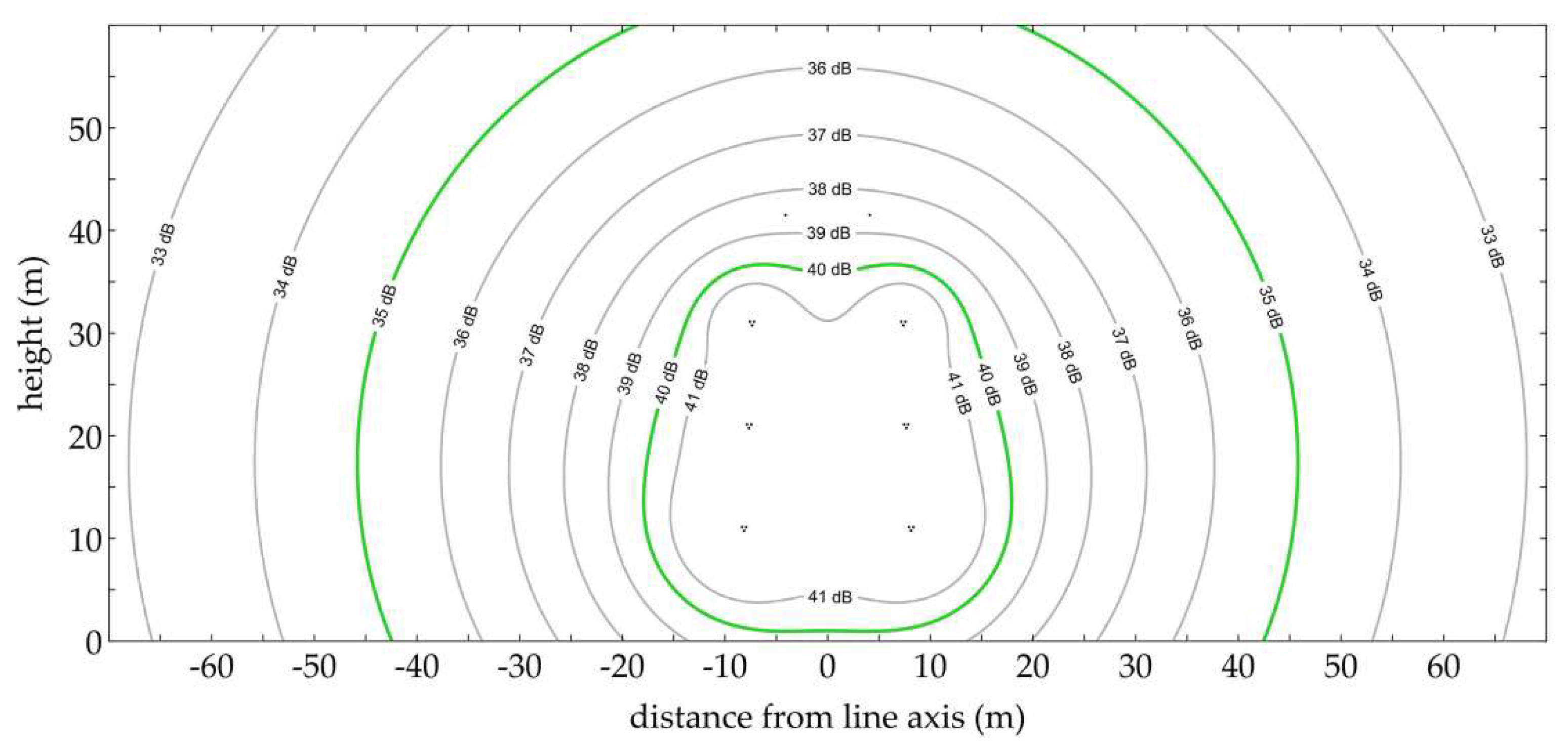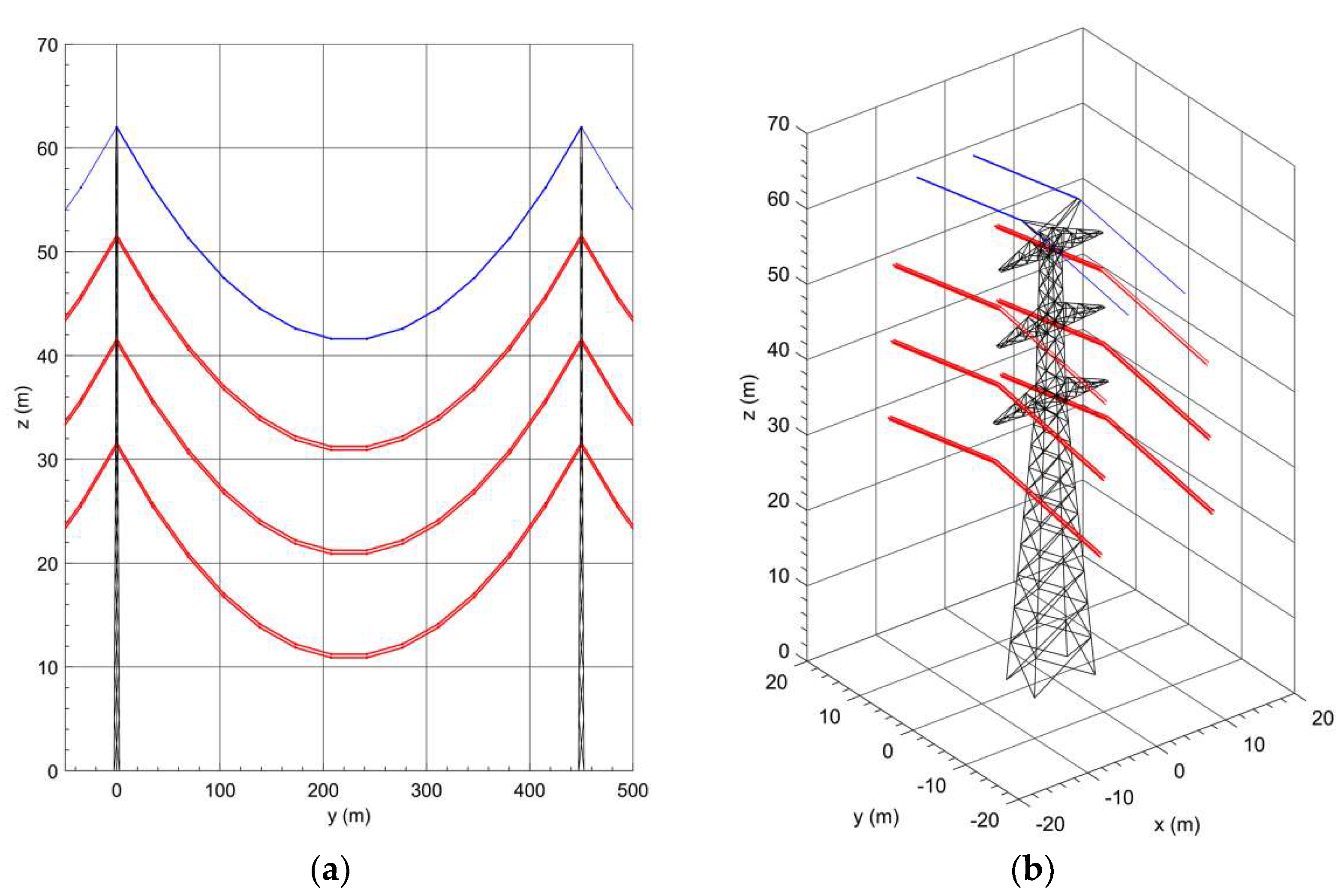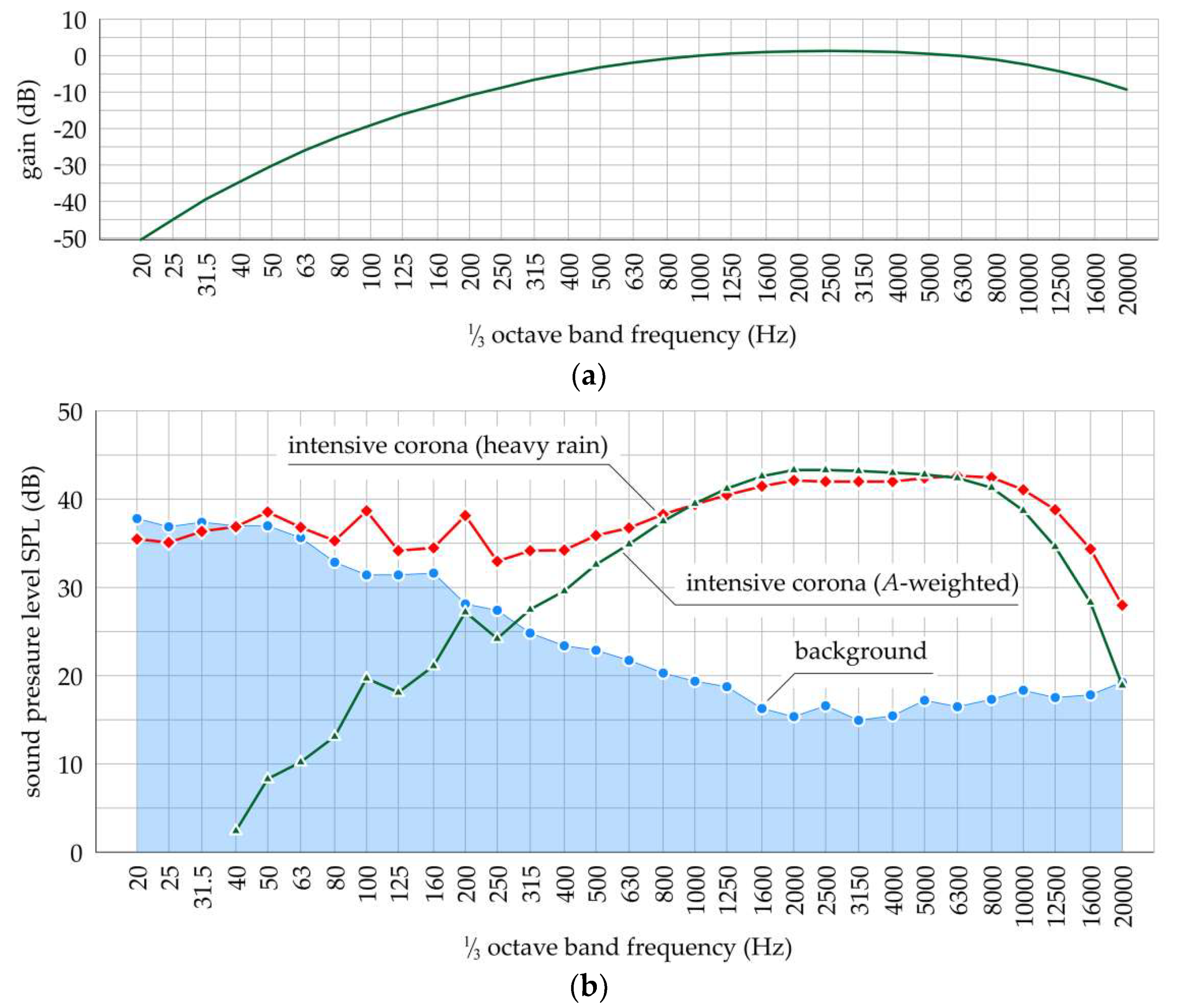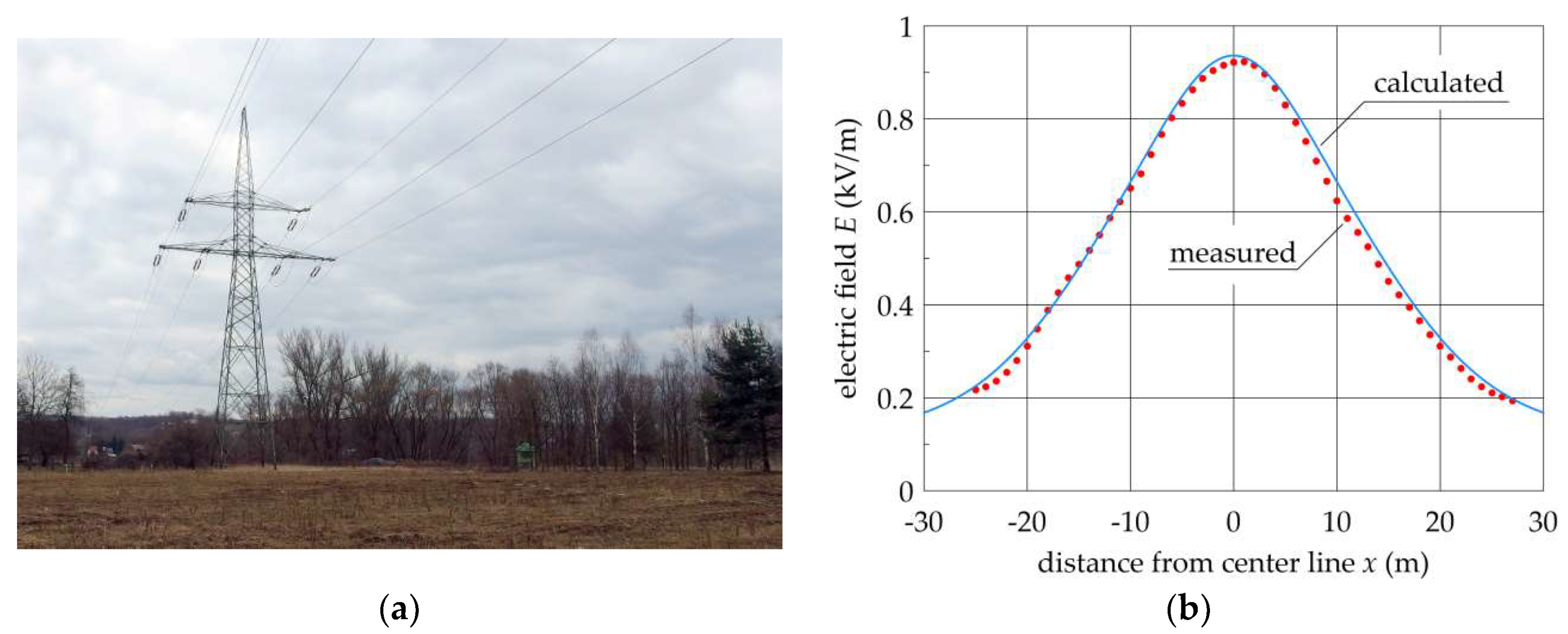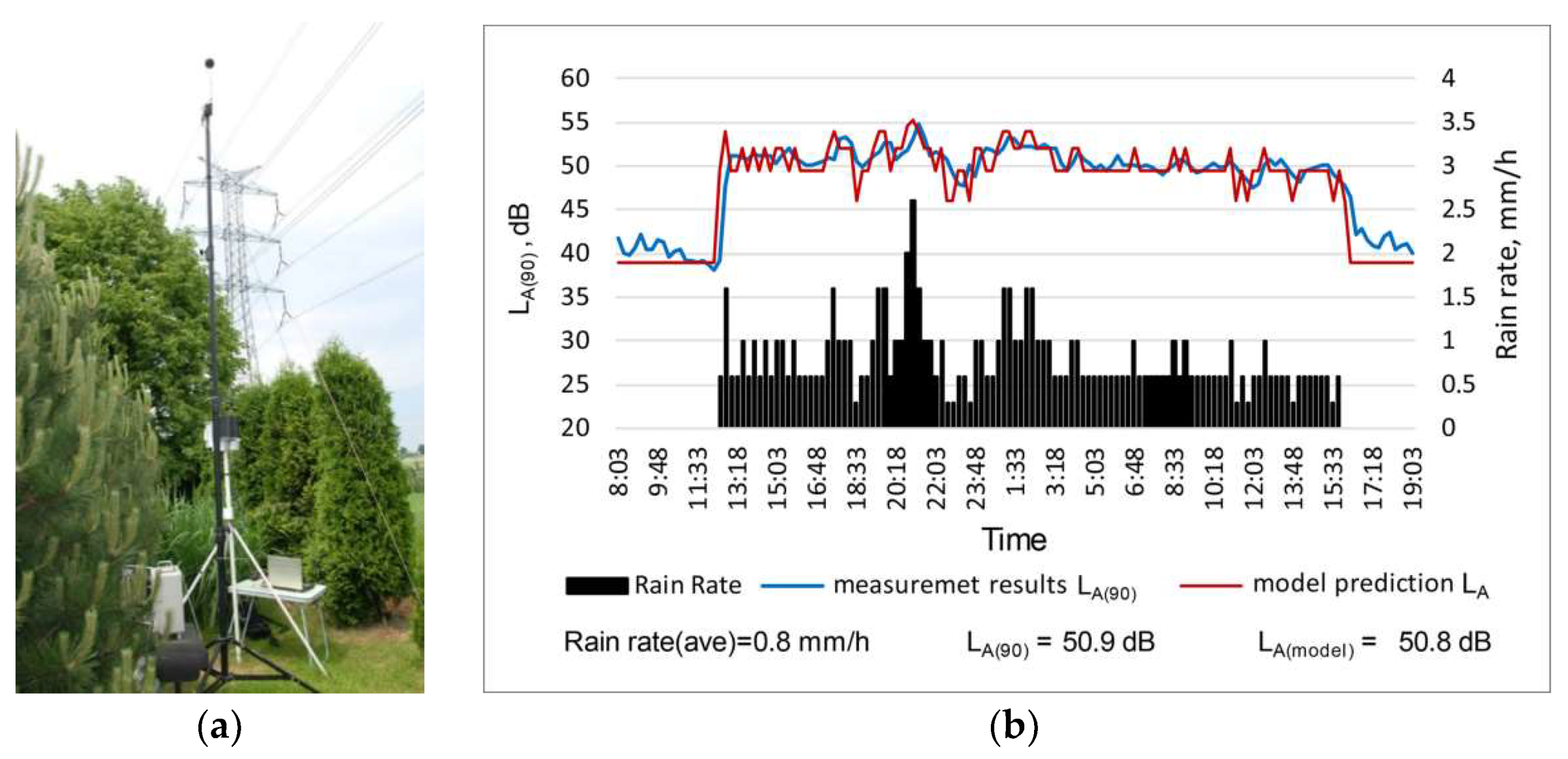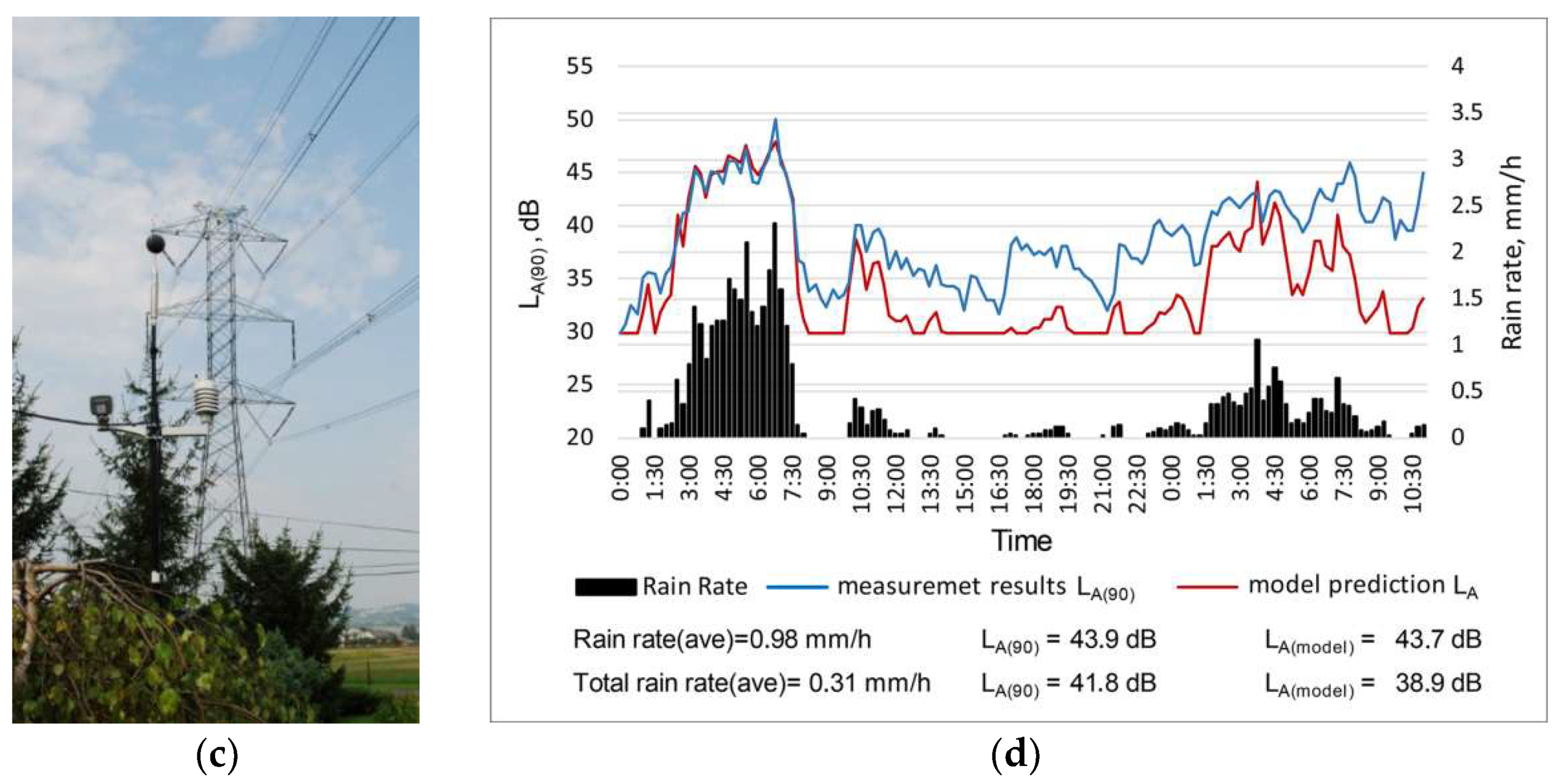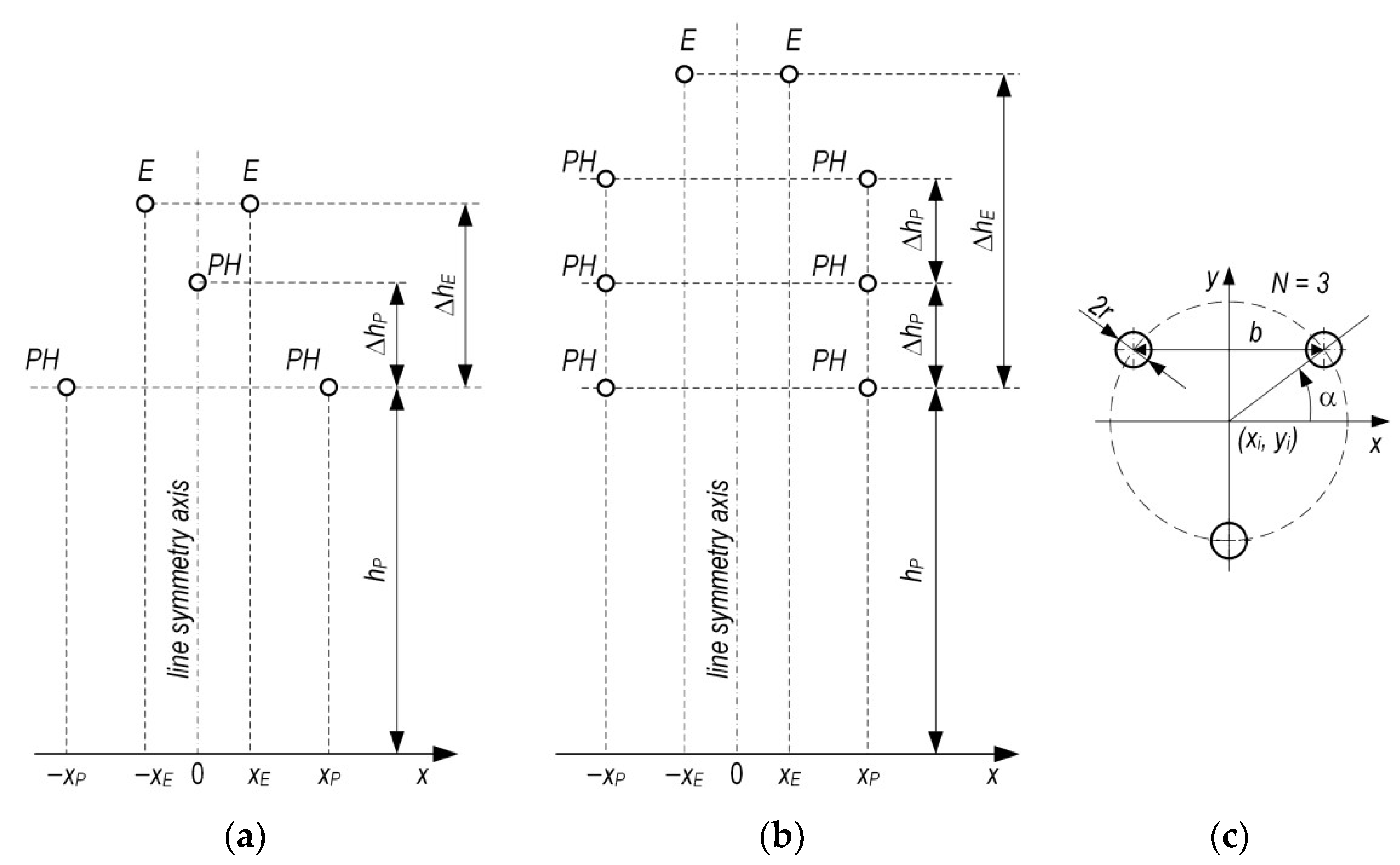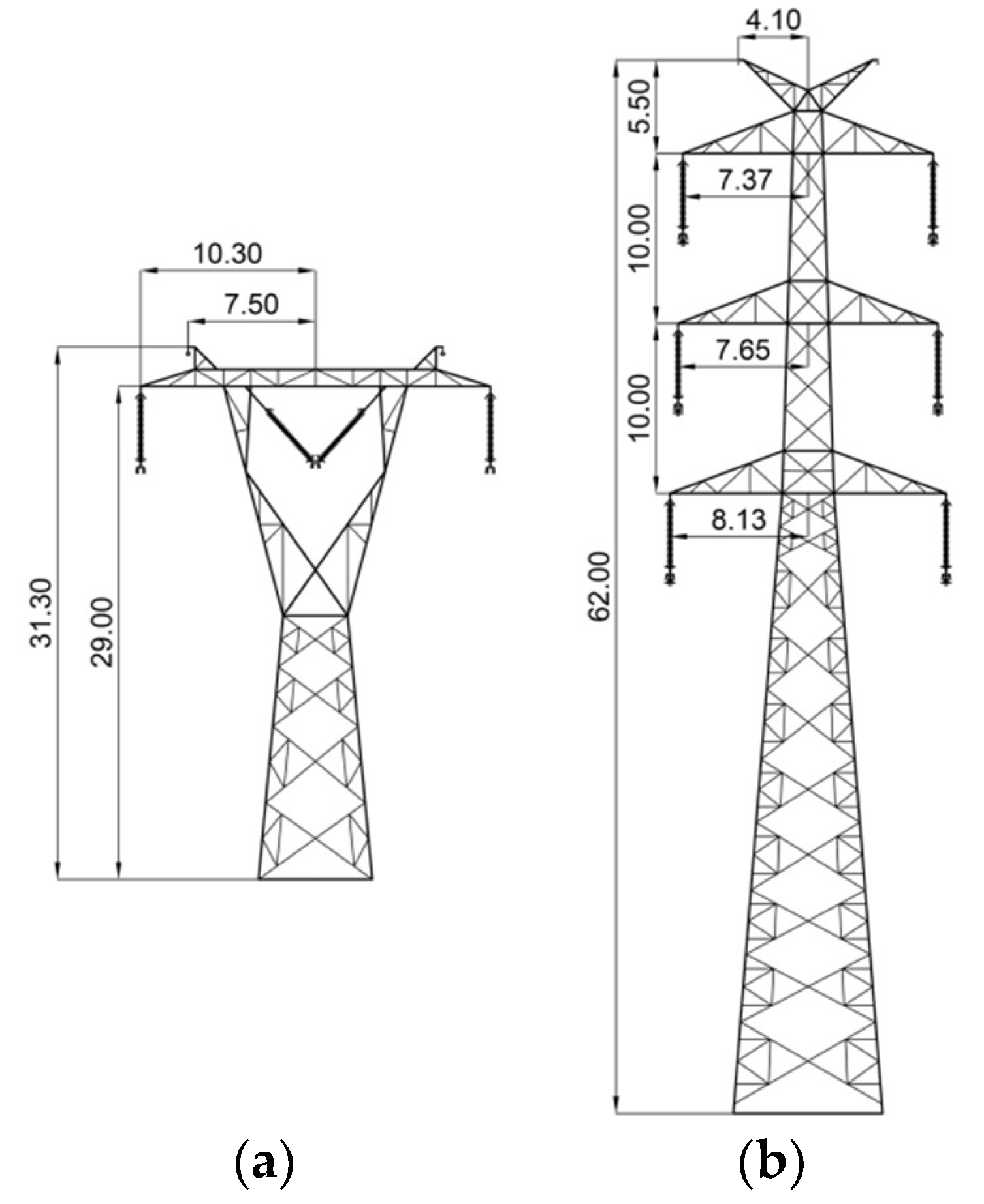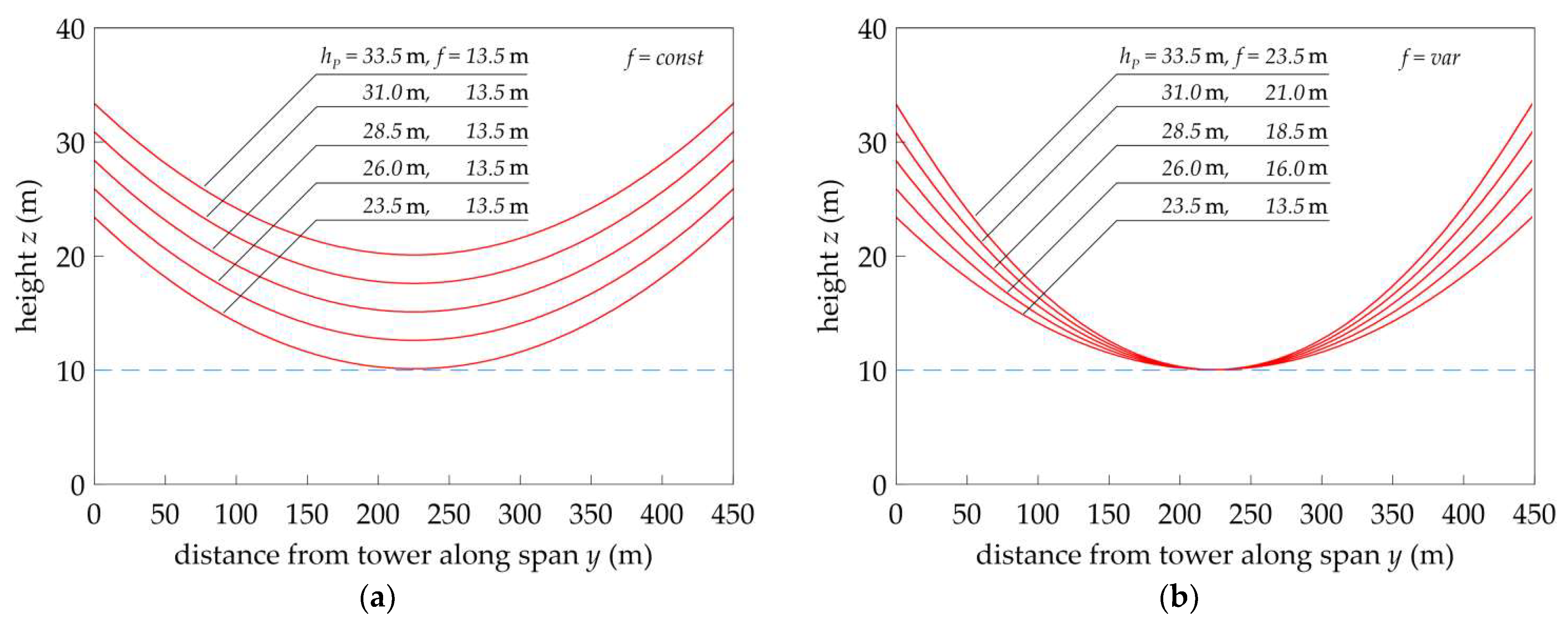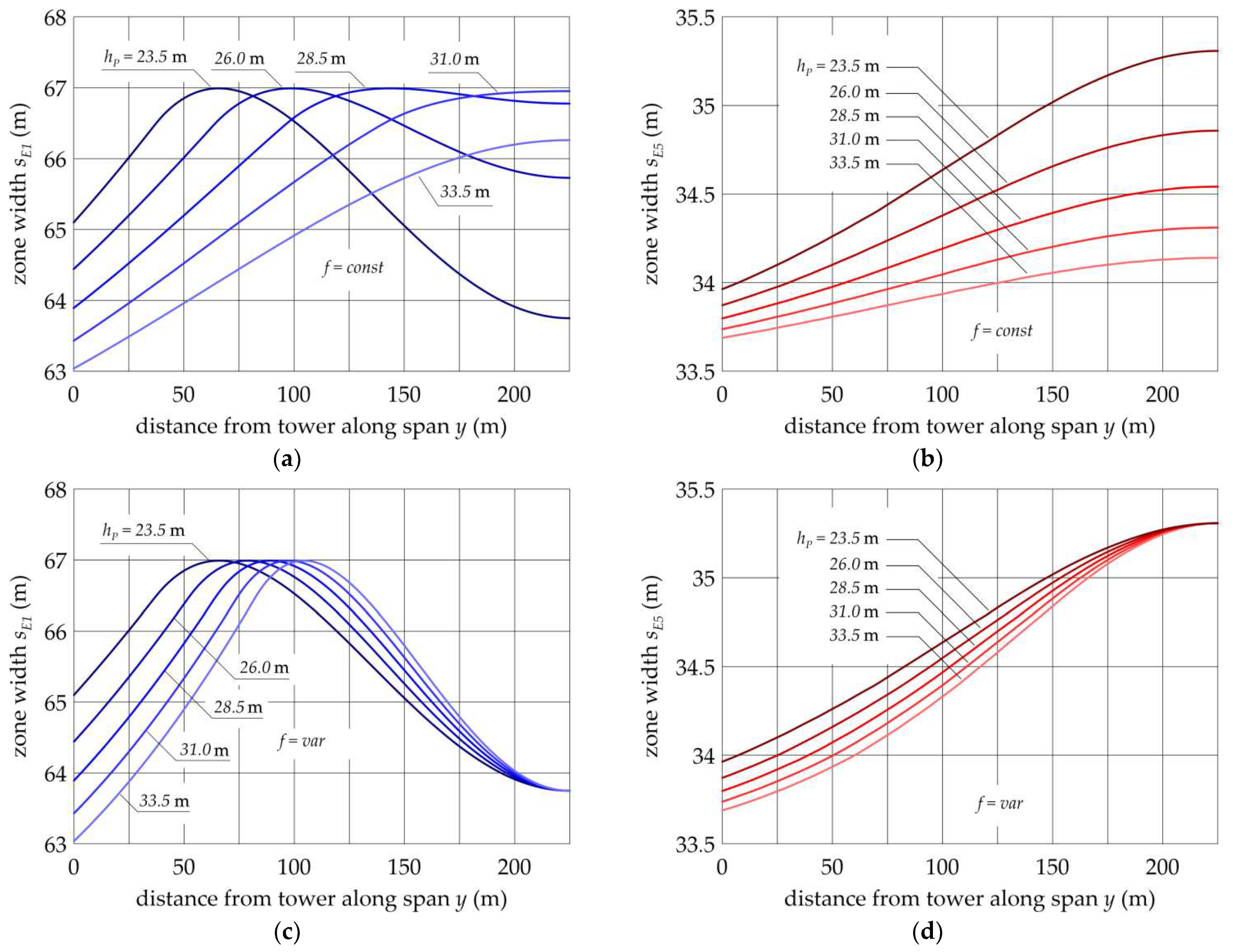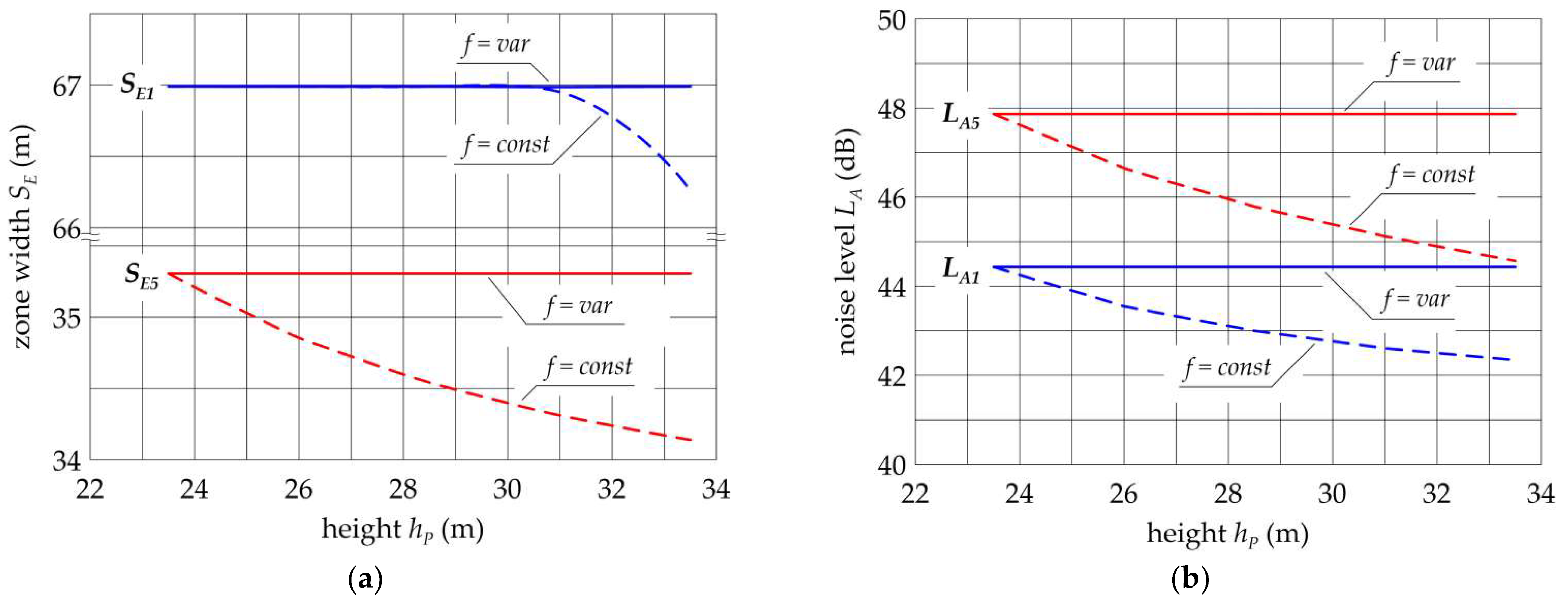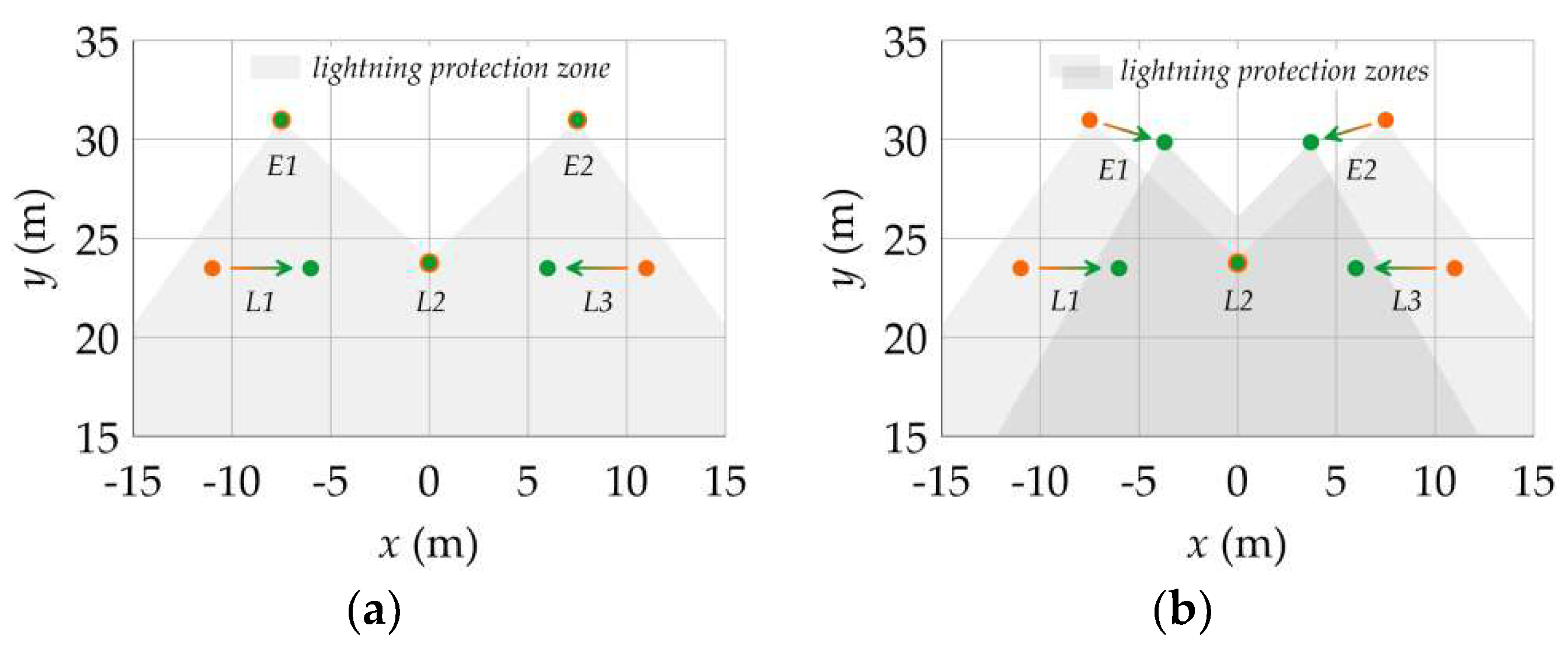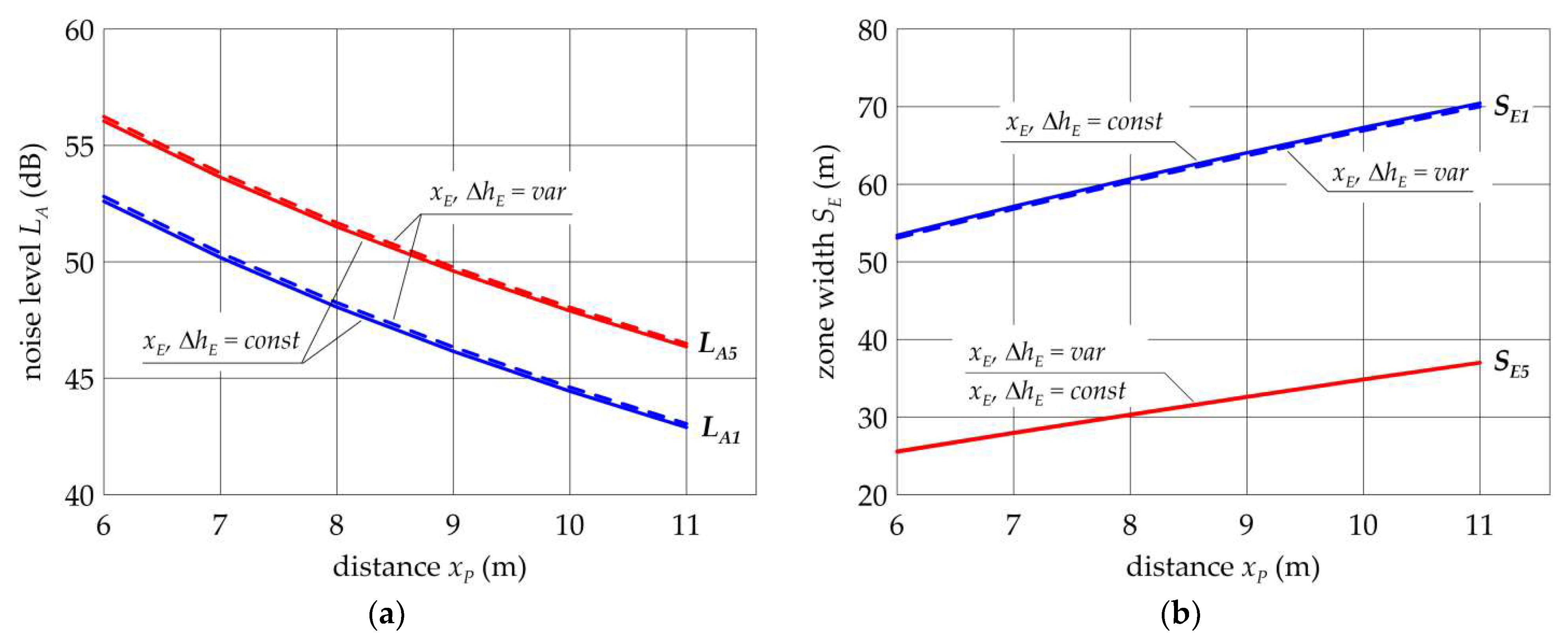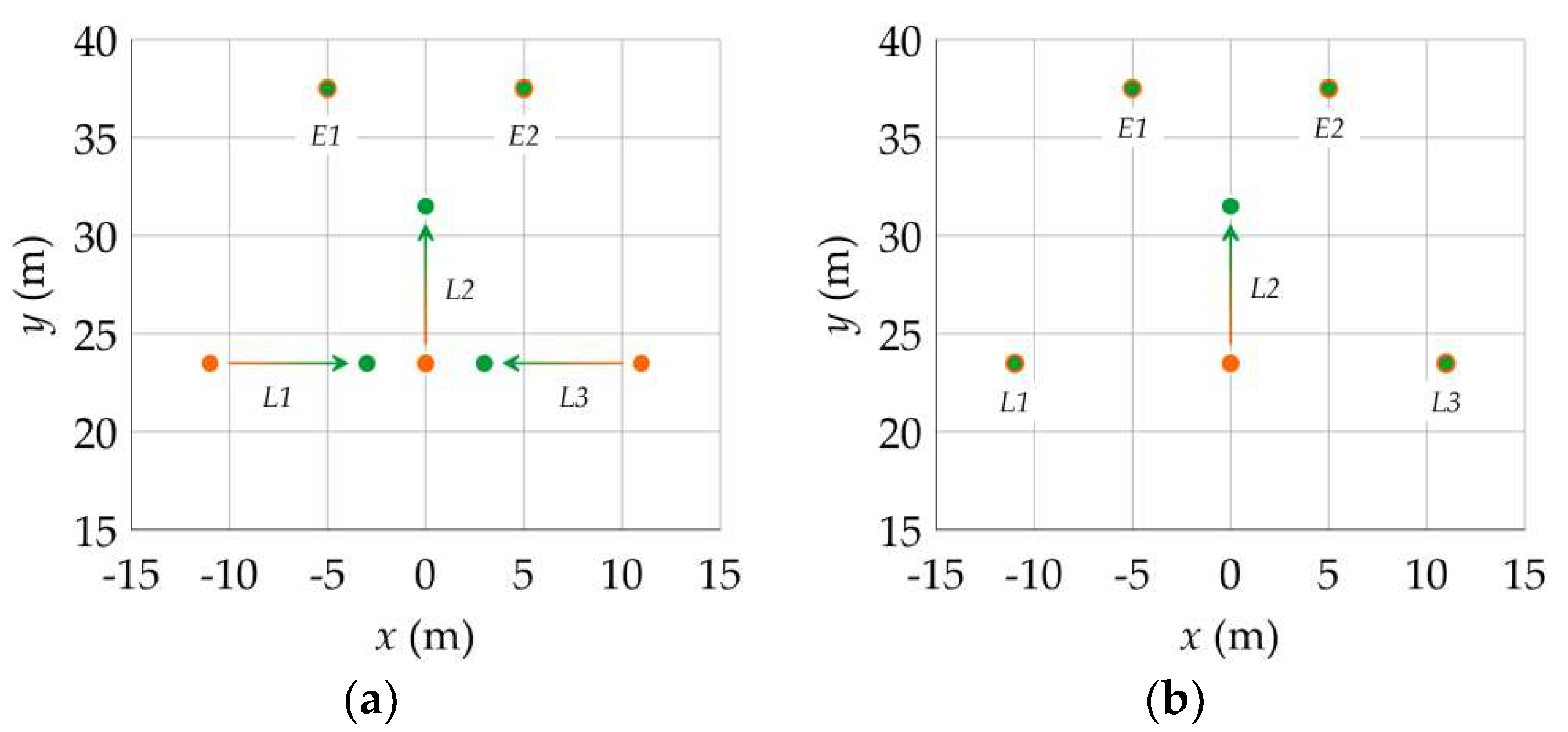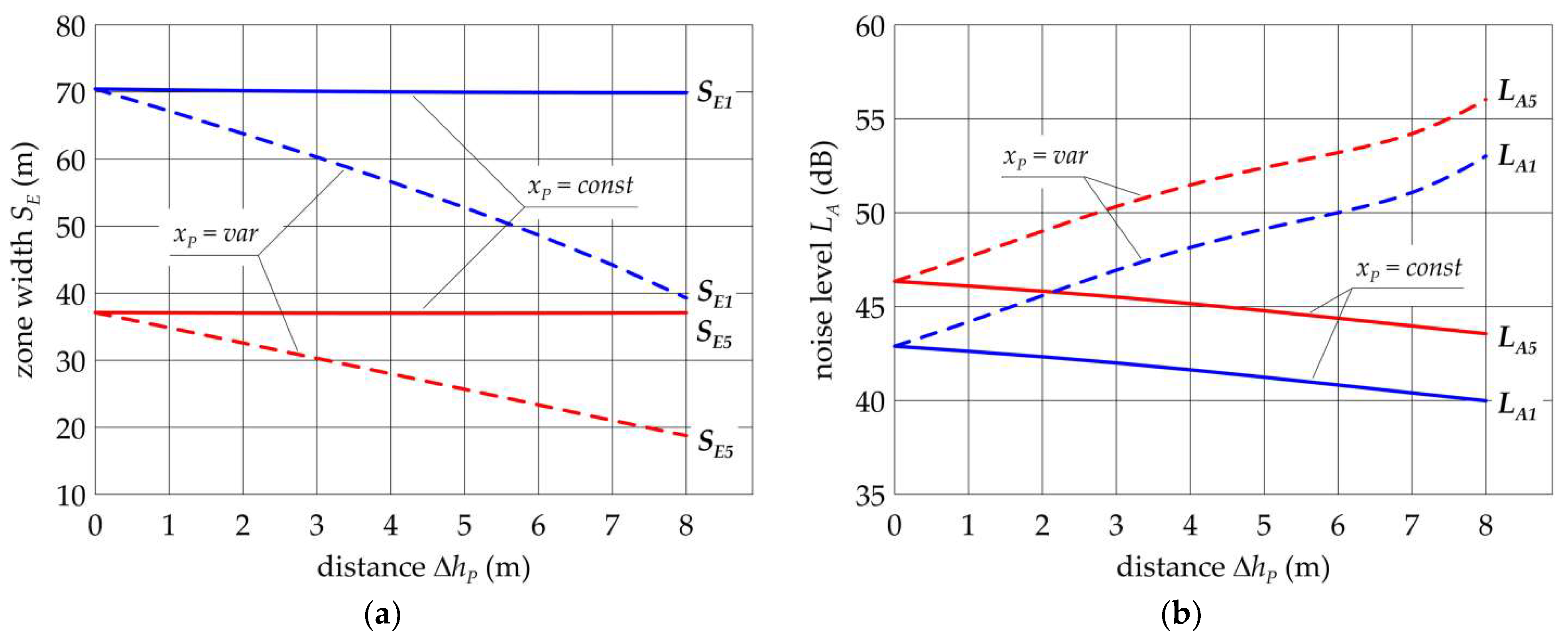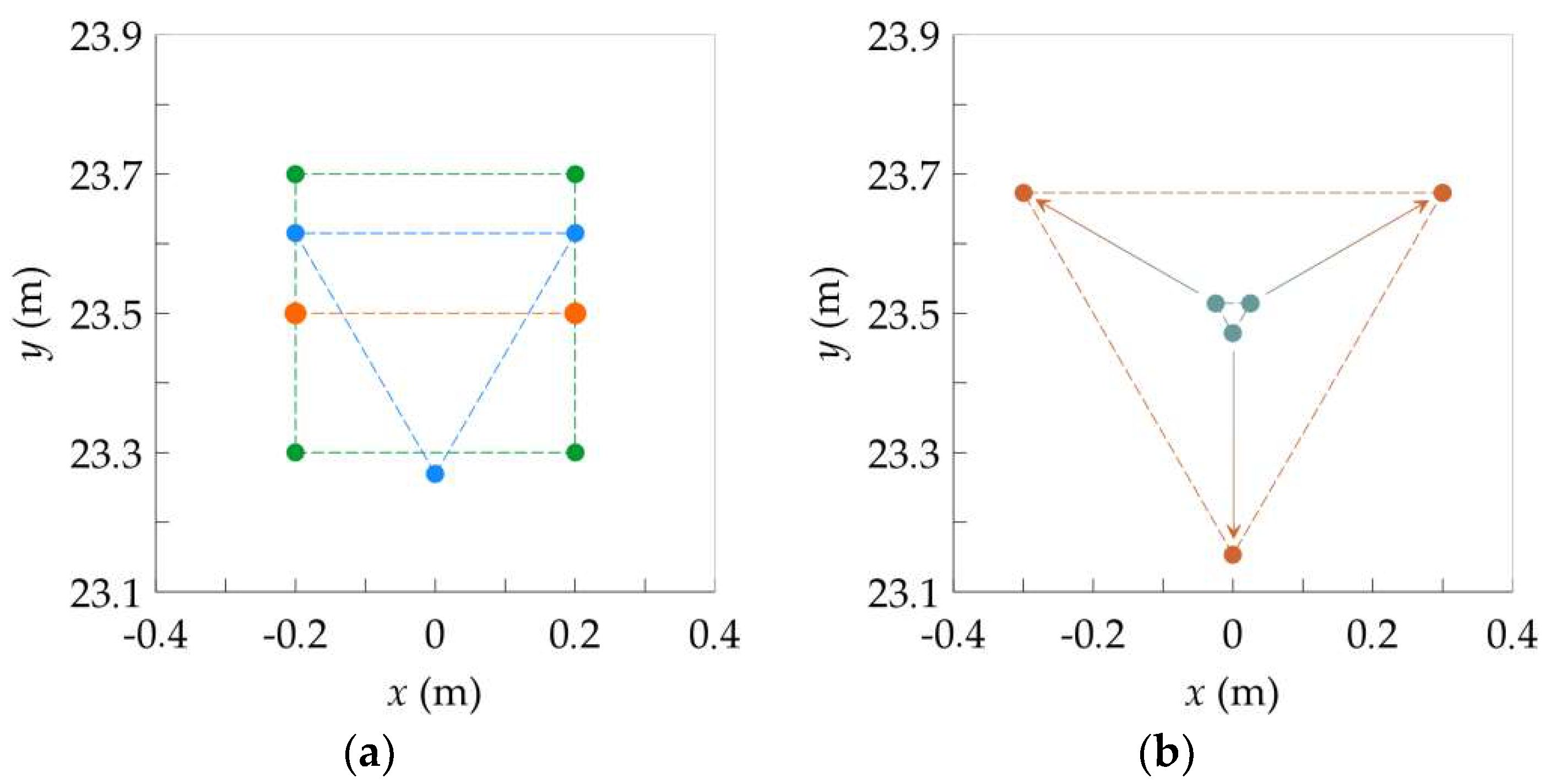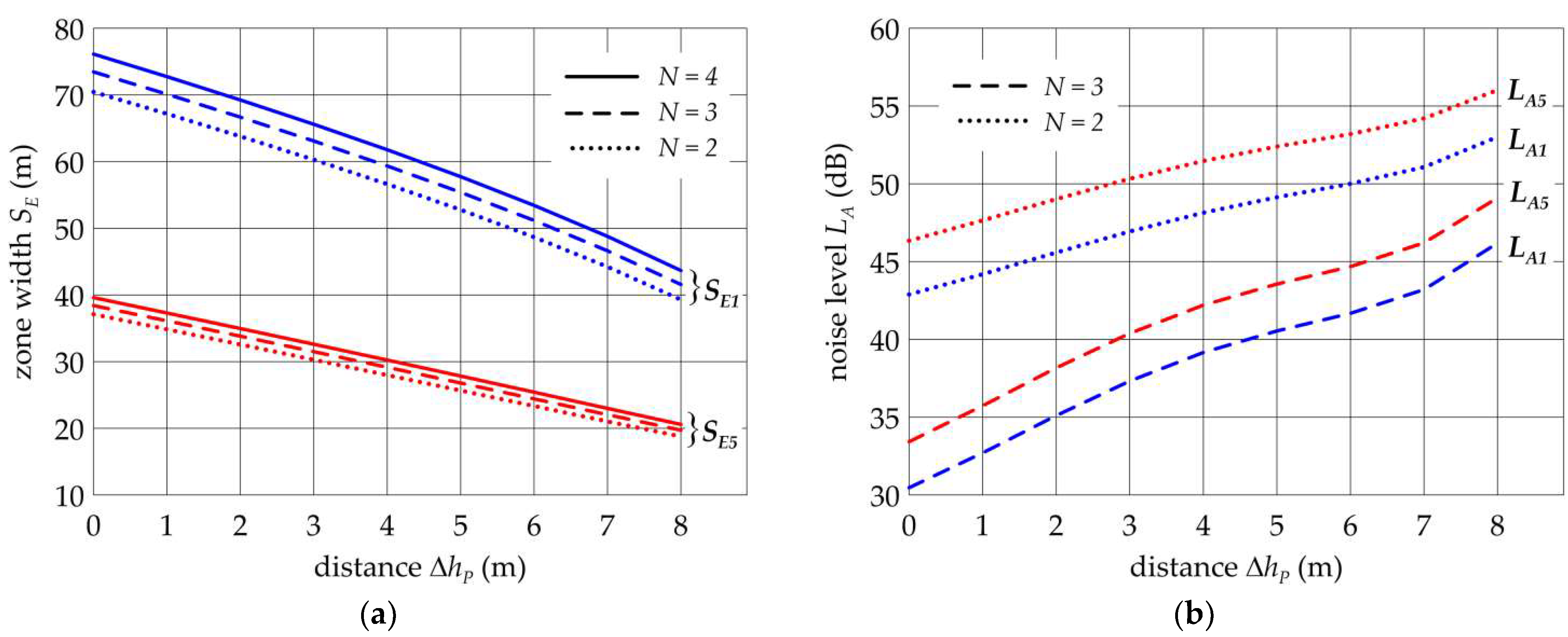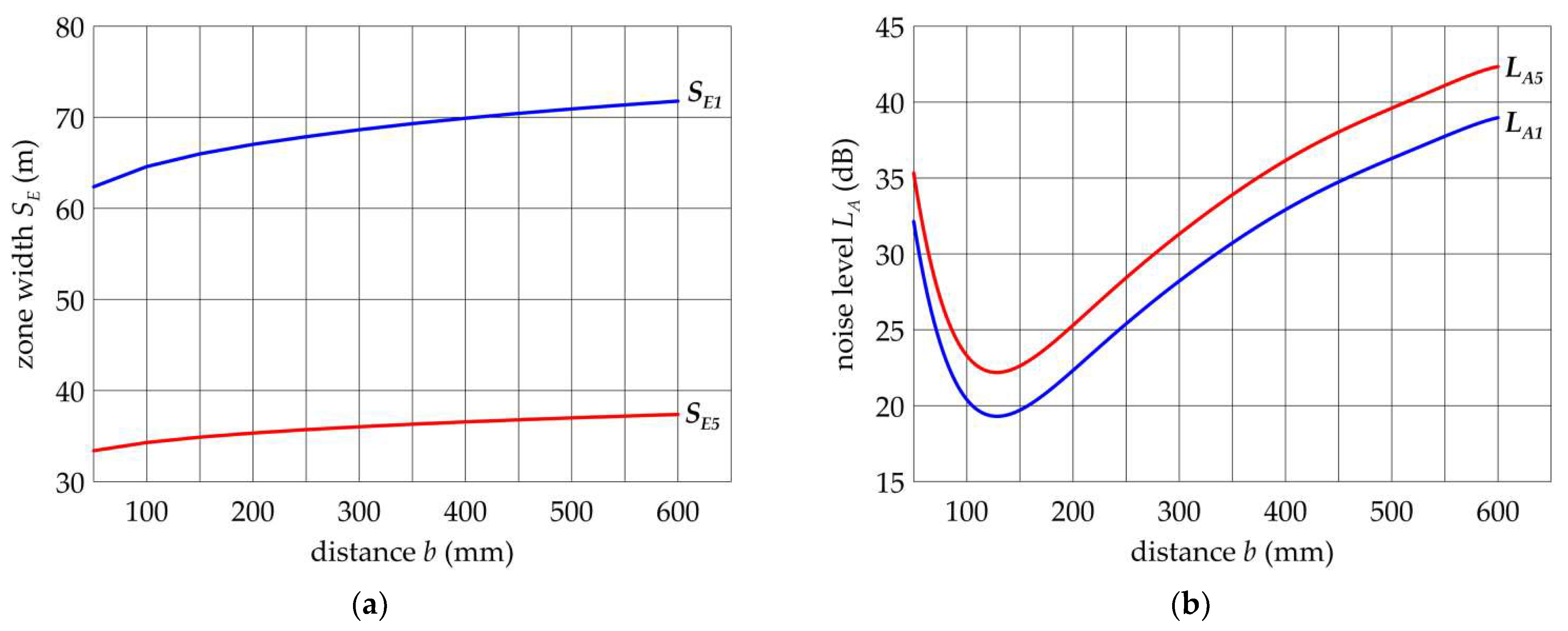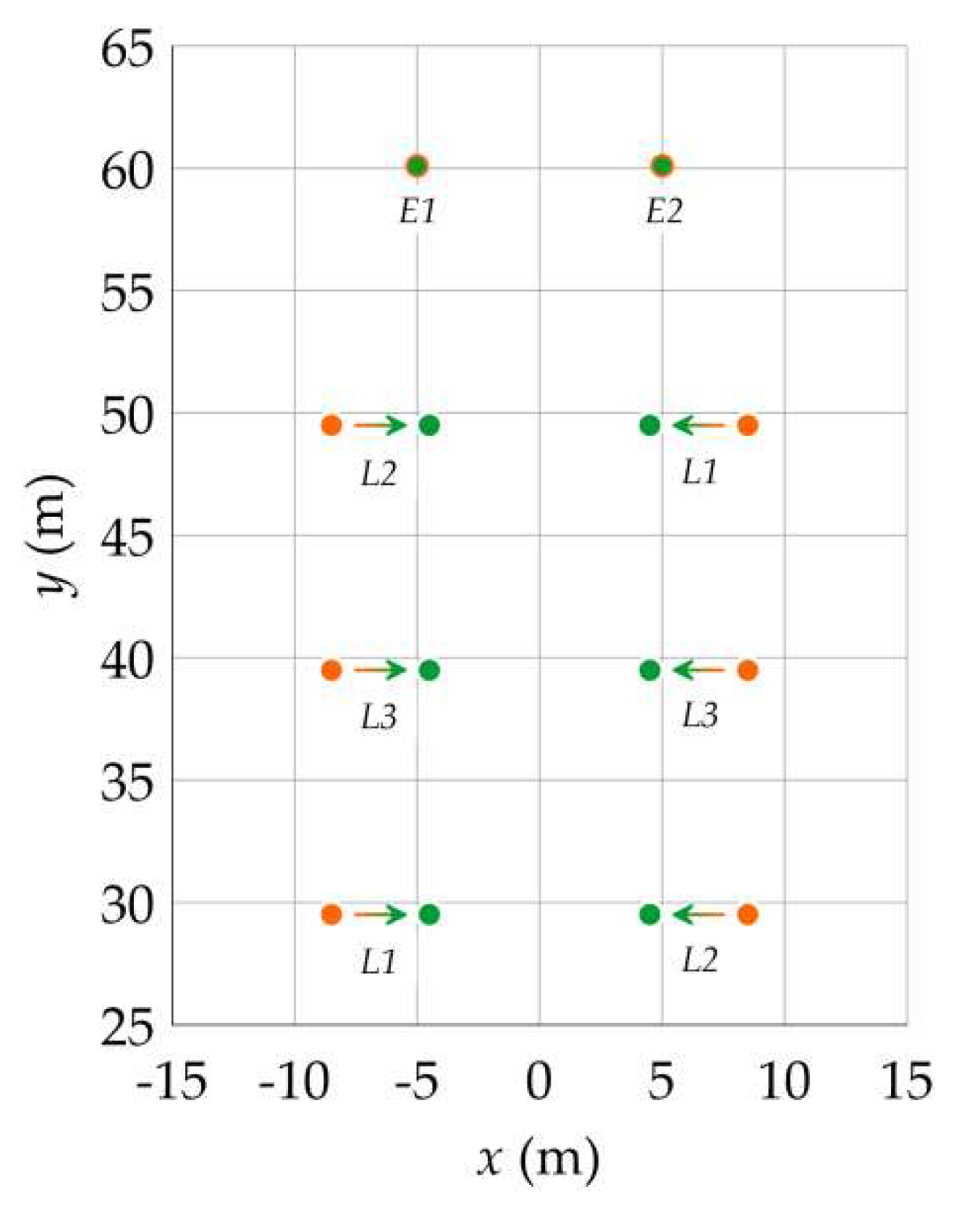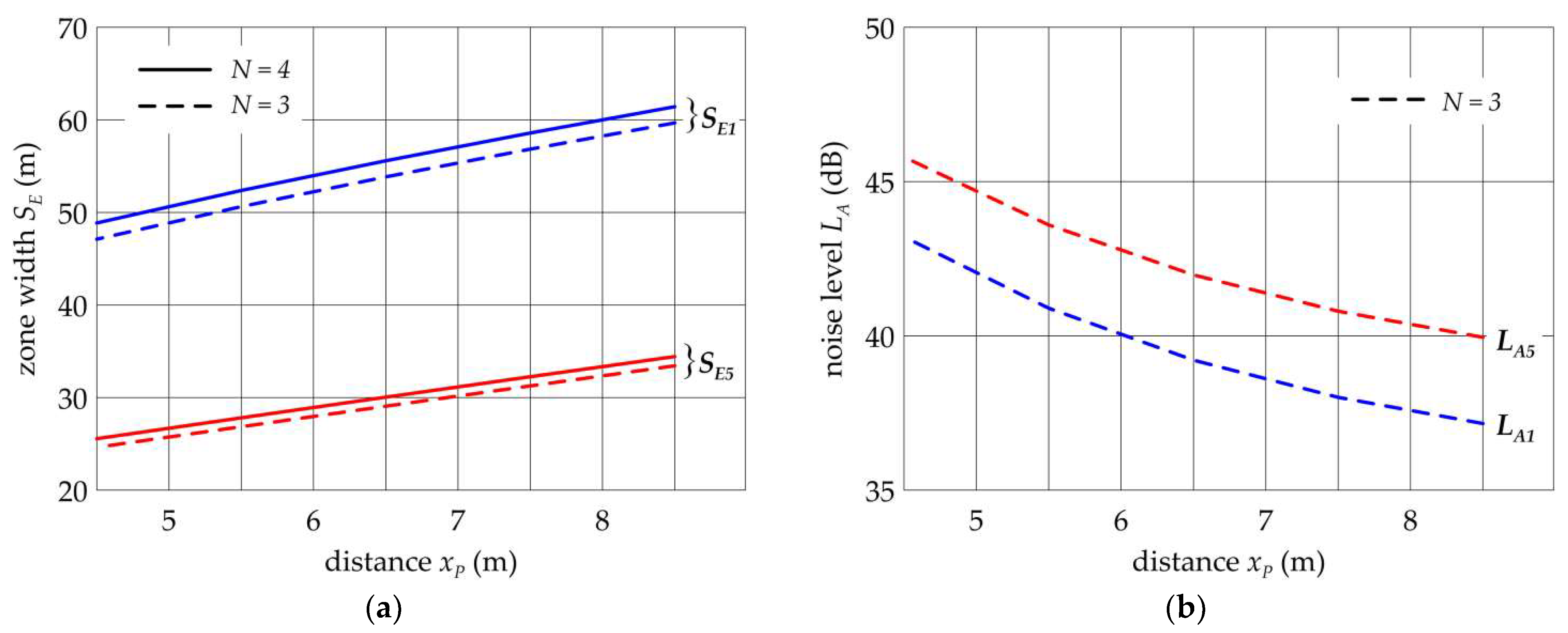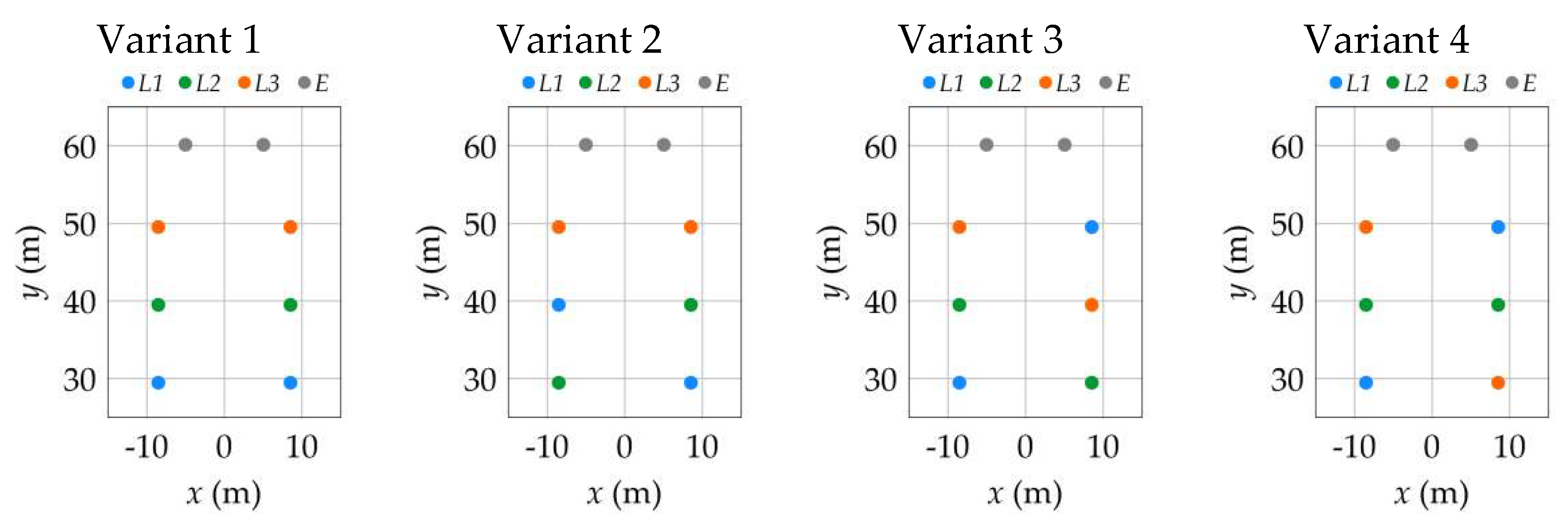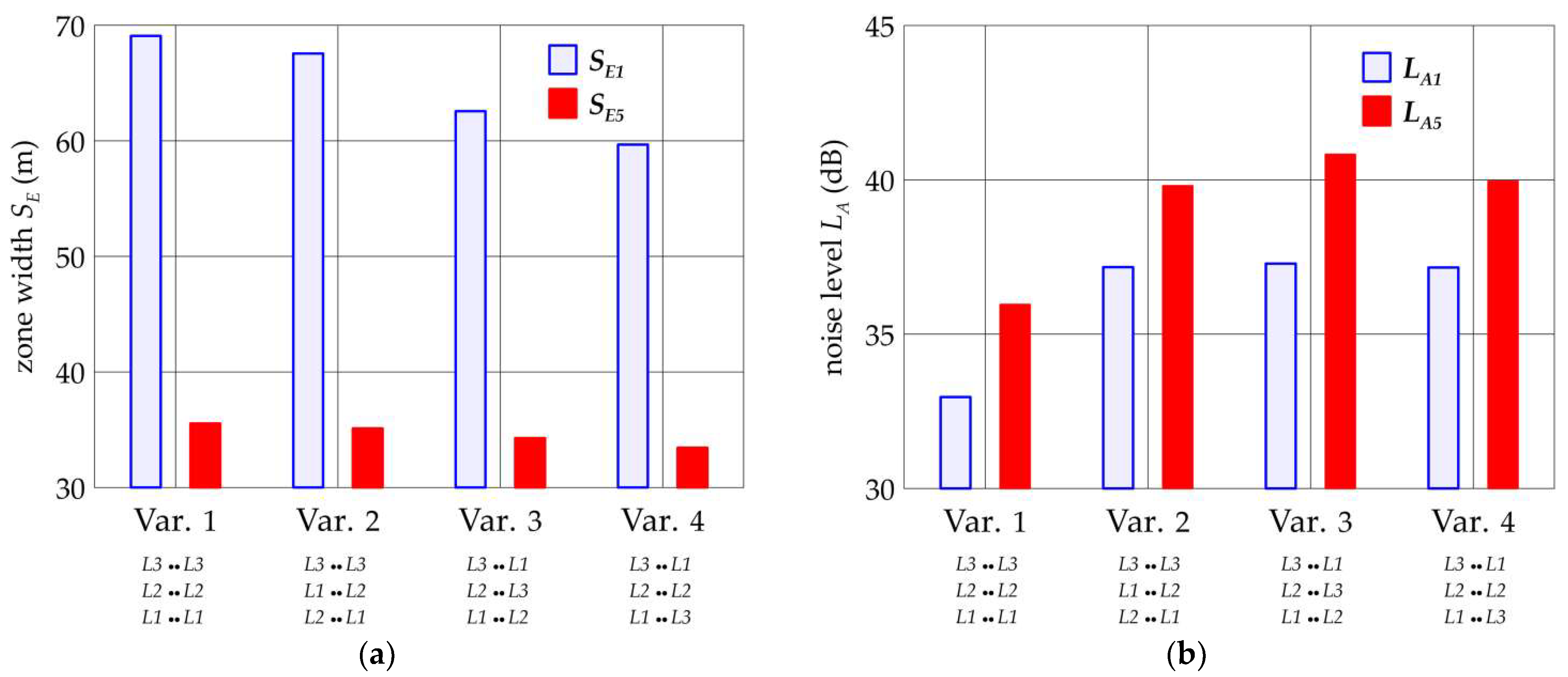1. Introduction
Limiting the negative environmental impact of high and extra-high voltage overhead power lines is a multi-aspect issue. In practice, activities aimed at reducing these impacts have been carried out since the moment electricity started to be transmitted and distributed—only the directions and priorities are changing in compliance with the current technical, legal, economic and environmental demands. Among the most important ones are the infrastructure corridors, legally distinguished areas on which the power lines can be localized. One of the elements of such a corridor is the power line influence zone, i.e., an area of the property where the property rights are impaired due to restrictions on land use and the need to ensure the safety of people and property.
The basic factor determining the width of the power line influence zone is the emission of the electromagnetic field to the environment. The growing ecological awareness causes that society continues to be more and more interested in the negative environmental impact of high and extra-high voltage overhead power lines. Respective legal restrictions are operational, especially when the electric component and magnetic component of an electromagnetic field with power frequency of 50 Hz or 60 Hz is involved. The parameters characterizing these elements are electric field strength (kV/m) and magnetic induction (µT). In 1998, the International Commission on Non-Ionizing Radiation Protection (ICNIRP) issued guidelines [
1], which set the limit values for these components at
E = 5 kV/m and
B = 100 µT. These values have been adopted in most countries and are also recommended by the European Union, as stated in the respective document of 1999 [
2]. In spite of this, some countries have local regulations [
3] in which the permissible values of electric and magnetic fields can be both higher/lower than values specified in the international documents. The requirements imposed by countries listed in
Table 1 exemplify this trend. It should be also mentioned that in 2010, ICNIRP published new guidelines [
4] in which the permissible value of magnetic field induction was increased from 100 µT to 160 µT.
The magnitude of electromagnetic field emission is affected by many factors, among which rated voltage and line current load are of primary importance. The second, equally important factor, is the spatial distribution of phase wires and earth wires. This factor is conditioned by the shape of the applied supporting structures and insulator chains. The range of the electromagnetic impact zone results from the spatial distribution of the electric field and magnetic field and is limited by the location for which the assumed permissible values were obtained.
Figure 1 presents an example of the electric field and magnetic field in the cross-section of a 400 kV double circuit line. In the example, the assumption of phase voltage symmetry was made, which is complied with in high and extra-high voltage networks. In addition, the load phase symmetry of each circuit was assumed.
These images visualize isolines for reference electric field strengths of 5 kV/m and 1 kV/m, and magnetic field isolines for reference magnetic induction values: 160 µT, 100 µT and 75 µT. These isolines were determined for the highest operating voltage of a 420 kV line, the highest power line current-carrying capacity of the line of 2500 A and the shortest distance of the phase wires from the ground of 11.0 m. The reference values of magnetic induction
B = 75 ÷ 160 µT are contained in the space where the electric field strength
E > 5 kV/m, as shown in
Figure 1. For this reason, the width of the electromagnetic influence zone of a power line is determined by the electric component of the electromagnetic field-widths
SE5 and
SE1 in
Figure 1. This statement is true not only for the images shown here, but can be generalized for other overhead power line structures as well.
The electric field of overhead power lines is strongly non-uniform, with the highest values occurring at the wire surface. If these values exceed the air ionization onset voltage gradient, the phenomenon of the corona effect will occur in the vicinity of wires. One of the main factors determining corona formation and its intensity is the design of phase wires.
Reduction of the electric field strength on the surface of the phase wires is achieved by using wire conductor bundles (
Figure 2). The bundle usually consists of 2 to 4 subconductors.
One of the negative corona effects is the audible noise. It significantly differs from the noise generated by other sources, e.g., transportation or industrial sources, because it strongly depends on such random causes as weather conditions or the surface condition of the line wires. The intensity of corona
A-weighted audible noise level (
Figure 3) in fair weather at a distance of 30 m from the lateral conductor, is about 30 ÷ 40 dB, while on rainy and humid days it may reach up to 55 dB.
International documents [
5,
6] on the negative environmental impact of noise do not mention power lines as a source. Therefore, general criteria specified in document [
7] have been adopted for assessing the environmental effect of noise generated by power lines. In practice, the following impact assessment indicators are used: general indicator of annoyance day-evening-night
Lden and detailed indicator of noise annoyance (sleep disturbances) at night
Lnight. The values of these indicators have been determined 4 m above the ground level.
Document [
6] provides recommendations for the highest values of these indicators, and which, depending on the source of noise, are:
Lden from 54 dB to 45 dB and
Lnight from 45 dB to 40 dB. Similar recommendations are included in document [
5], in which
LAeq of 50 ÷ 55 dB during the day, and 5 ÷ 10 dB lower values for the night were assumed as annoying noise values. It should be noted, however, that predicting power line noise and relating the obtained values to the quoted limits is often problematic due to the strong impact of weather conditions on the level of generated noise [
8,
9].
Authors of this paper study the impact of power line design parameters determining the spatial arrangement of its wires on the width of electric field impact zones
SE5 and
SE1. It should be highlighted the originality of the authors’ research based on the complementary consideration of the electric field and the acoustic emission in the vicinity of the line. Such an approach has not been presented in the subject literature till now. In addition, it should be noted that the analysis was performed using developed programs, and experimentally verified authors models presented in
Section 2. These models was used to determine the electric field in the vicinity of the line and on the conductor surfaces, as well as the noise generated by the line. The objects and scope of the study and the construction parameters of single and double circuit lines are described and specified in
Section 3. The range of possible changes in the values, resulting from the applied standards and technical feasibility, was determined for these parameters.
Section 4 presents the results of investigations of impact of the considered parameters on the widths of zones
SE5 and
SE1 of selected single and double circuit 400 kV lines, as well as the impact on noise levels
LA5 and
LA1 at the border of zones
SE5 and
SE1. The results presented in the article can be used as a basis for selecting the best design solution for the line in terms of minimizing the negative environmental impact. They also suggest possible directions of design changes for lines of other voltages. The results of the analysis presented in the article have allowed us to identify the crucial construction parameters of the line, which is important for the width of the electric field exposure zones. The research has shown that in some cases, it is possible to reduce the width of the zones by up to 50%.
3. Subject and Scope of Research
The computational models presented in
Section 2 were used for analyzing zone widths
SE5 and
SE1 of the electric field impact of 400 kV lines, and studying noise levels
LA5 and
LA1 at the borders of zones
SE5 and
SE1. The tests were performed for single and double circuit 400 kV power lines, whose symmetrical wire configurations and arrays are shown in
Figure 8. The analysis assumes symmetry of the phase voltages.
Structural parameters (
Table 2), which are significant for the zone widths
SE1 and
SE5, were indicated for the feasibility analysis of electric field impact reduction. The purpose of this study was to determine the effect of changes in these parameters on the possibility of reducing
SE1 and
SE5 zones.
The parameters shown in
Table 2 can be classified into three groups. The first group includes parameters
xP,
hP, and
hP, which determine the geometric arrangement of phase wires in the line’s cross-section. Together with parameter
fP they form a system that gives full information about the location of phase wires in a given line’s cross-section. The values of
hP and
fP parameters are closely related to the required distance from the ground. The second group includes parameters
xE and
hE, which together with
fE determine the place of the earth wires. The third group consists of
N and
b parameters that characterize the structure of the bundled phase conductors (
Figure 7c).
The range in which these parameters oscillate results from the normative requirements [
26] ensuring safety insulation clearances determined by the rated voltage, overvoltage and environmental conditions. Permissible ranges and typical values of parameters of the 400 kV line are given in
Table 3 and
Table 4.
Figure 9 shows the schemes of the single and double circuit 400 kV line towers adopted for the study. The indicated dimensions can be treated as typical for this level of rated voltage.
In the single circuit line (
Figure 9a), the phase conductors were assumed to be made as double conductor bundles
N = 2,
2r = 31.50 mm,
b = 400 mm and form a flat conductor configuration. Whereas in the double circuit line (
Figure 9b) an assumption was made that the phase wires are made as triple conductor bundles
N = 3,
2r = 26.10 mm,
b = 400 mm forming a vertical conductor configuration. The insulator chains are 5.50 m long, except for the central phase chain of the single circuit line, for which the length is 5.25 m. Moreover, span lengths of 450 m, as well as equal phase and earth wire sags
fP =
fE = 13.5 m were also assumed.
4. Analysis of Influence of Line Design Parameters on SE5 and SE1 Zone Widths
The first step of the analysis lied in checking out whether or not it is possible to reduce the width of the single circuit line impact zone (
Figure 9a) by increasing the wire height
hp at tower from 23.5 m to 33.5 m.
Figure 10 shows the outer phase conductor profiles for selected heights
hp. The analysis considers both the case of a constant sag
fP =
fE = 13.5 m (
Figure 10a) and variable sag
fP =
fE =
var situation at a constant minimum conductor-to-ground distance of 10 m (
Figure 10b).
Figure 11a,b illustrate the widths of zones
SE5 and
SE1 along the line span for a constant sag case, and
Figure 11c,d for a variable sag case. On the other hand, the dependence of zone widths
and
in a function of conductor height
hp on tower is presented in
Figure 12a.
Figure 12a shows that for
f =
var, the zone widths do not depend on height
hp. For
f =
const, the zone widths decrease with the increase of height
hp, zone
SE1 is reduced by 0.7 m and zone
SE5 by 1.2 m. It should be noted that the increase of height
hp has a negligible effect on the zone width reduction, but it has a significant effect on the noise level decrease. This has been illustrated in
Figure 12b showing a relationship of corona audible noise levels
LA1 and
LA5 at the boundary of
SE1 and
SE5 zones. The noise impact is reduced for
f =
const. In this case, by increasing the height of conductors by 10 m the noise levels
LA1 and
LA5 are reduced by 2.1 dB and 3.3 dB, respectively.
In the next step of the analysis, parameter
xP was examined for different values and the effect it brings about. Two variants shown in
Figure 13 were considered.
In the first variant (
Figure 13a) an unchanged position (
xE, Δ
hE =
const) of earth wires is assumed to ensure a continuous lightning protection area. The zone shown in
Figure 13a refers to the outermost phase and the inner phase conductor angles of lightning protection of 20° and 45°, respectively. In the second variant (
Figure 13b), it is assumed that the decrease of
xP is accompanied by a simultaneous change in the position of earth wires (
xE, Δ
hE =
var) to ensure constant values of the outermost phase and the inner phase conductor protection.
Figure 14a shows the width dependence of zones
SE1 and
SE5 as a function of distance
xP, and
Figure 14b visualizes the noise level dependence of
LA1 and
LA5. The variation of
xp between
xP(min) = 6 m and
xP(max) = 11 m was considered. The value of
xP(min) results from normative requirements (e.g., [
26]) regarding voltage-dependent clearance distances. On the other hand, the value of
xP(max) is limited by both technical and economic factors. The technical constraints arise from the increase in the tower bending moment with the growth of
xP. This, in turn, results in the higher cost of the tower, and consequently, the need to increase the mechanical strength of its structure and foundations. Another constraint of an economic nature is the increasing width of the right of way.
Figure 14 shows that both zone widths and noise levels are virtually independent of the location of earth wires. With the decreasing distance
xP from 11 m to 6 m zone width
SE1 is narrowed by 17.0 m (24.1%), and zone
SE5 by 11.4 m (30.9%). However, this reduction is accompanied by a significant increase in noise levels
LA1 and
LA5 by 9.8 dB.
The range of parameter
xP values can be broadened in the analyzed 400 kV line below the lower boundary
xP(min) = 6 m if the phase conductor configuration is changed from flat to triangular. Two variants of this reconfiguration, involving the increase the height of the central phase by Δ
hP = 0 ÷ 8 m, are presented in
Figure 15. The first variant assumed a simultaneous decrease of parameter
xP from
xP(max) = 11 m to
xP(min) = 3 m (
Figure 15a). In the second variant, a constant value of
xP = 11 m is assumed for the outermost phase (
Figure 15b).
Increasing the height of the central phase conductor while decreasing the distance of the outermost phase conductors (
xP =
var), significantly reduces the width of the electric field impact zones (
Figure 16a). In the analyzed 400 kV line, a narrowing of the zone width
SE1 by 31.2 m (44.2%), and zone
SE5 by 18.3 m (49.4%) is achieved. However, this reduction is accompanied by a significant increase in noise levels
LA1 and
LA5 by 10.1 dB and 9.7 dB, respectively (
Figure 16b). If the position of the outermost phase conductors remains the same (
xP =
var), the change of distance Δ
hP does not affect zone widths
SE1 and
SE5, though reduces noise levels
LA1 and
LA5 by 2.8 dB.
The considerations presented so far concentrated on a 400 kV line in which phase conductors consisted of two-sub-conductor bundles with the following parameters (
Figure 8c):
N = 2, 2
r = 31.50 mm,
b = 400 mm, α = 0°. The type of the applied bundle conductors affects the electromagnetic and noise impact of the power lines. Further studies of the case shown in
Figure 15a were carried out to analyze this influence. Two options were considered: (i) changing number
N of sub-conductors in the bundle, (ii) changing distance
b between sub-conductors in the bundle.
In the first variant, the tests were carried out for three types of bundled conductors (
Figure 17a): (i)
N = 2 (2
r = 31.50 mm,
b = 400 mm, α = 0°), (ii)
N = 3 (2
r = 26.10 mm,
b = 400 mm, α = 30°),
N = 4 (2
r = 26.10 mm,
b = 400 mm, α = 45°). In the second variant, the tests were performed for
N = 3 conductors, assuming a variation of distance
b from 50 mm to 600 mm (
Figure 17b).
The increasing number of
N wires in a bundle results in a broader width of zones
SE1 and
SE5 (
Figure 18a). For Δ
hp = 0 (flat configuration) the triple bundle (
N = 3) increases the zone width
SE1 by 3.0 m (4.3%) and zone
SE5 by 1.3 m (3.5%), as compared to the zone widths of double conductor lines (
N = 2). For the quadruple conductor bundle (
N = 4), these values are even higher and are 5.7 m (8.1%) and 2.5 m (6.7%), respectively. For Δ
hp = 8 m the triple conductor bundle (
N = 3) makes zones
SE1 and
SE5 wider by 2.3 m (5.8%) and by 0.9 m (5.0%), respectively. In the case of a quadruple conductor bundle (
N = 4), these values are 4.4 m (11.1%) and 1.8 m (9.7%), respectively.
Although the increased number
N of conductors in a bundle is associated with an adverse effect of a bigger electromagnetic impact, a significant reduction of noise impacts is achieved (
Figure 18b). When a three conductor bundle (
N = 3) is used, the noise levels
LA1 and
LA5 decrease by ca. 12.5 dB for Δ
hp = 0 m and by about 6.9 dB for about Δ
hp = 8 m as compared to a double conductor bundle line (
N = 2). In the case of a quadruple conductor bundle line (
N = 4), the electric field strength at the wire surface is below the initial corona, and no noise impact is observed.
The sub-conductor distance
b in the bundle affects zone widths
SE1 and
SE5 (
Figure 19a). In the considered range of distance
b from 50 to 600 mm the zone width
SE1 increases by 9.4 m (15.1%) and
SE5 by 4.0 m (11.9%). The effect of parameter
b on the noise level is complex (
Figure 19b). Initially the values of
LA1 and
LA5 decrease with the increase of
b and for
b ≈ 150 mm reach the lowest values 19.7 dB and 22.7 dB. A further increase of
b results in an increase of the noise level values. However, in practice, the problem of choosing the optimum value of distance
b is complex. Many other factors influence the choice, primarily the number of sub-conductors, in the bundle climatic conditions and the resulting need to prevent excessive icing as well as the effects of sub-span vibrations between conductor spacers. For these reasons, distance values
b are usually equal to 300–500 mm.
Conclusions resulting from the analyses of the single circuit lines are also valid for double circuit lines as far as qualitative aspects are concerned. This applies first of all to the impact of
xp parameter, which in the case of the double circuit lines is the phase conductor horizontal distance to the axis, and the effect of the phase conductors design.
Figure 20 shows the range of changes of the phase conductors on a double circuit 400 kV line adopted for the analysis from
Figure 9b. A constant location of earth wires was assumed
xE, Δ
hE =
const and a constant distance Δ
hP =
const phase conductors.
Figure 21a shows the zone width relationships of
SE1 and
SE5 in a function of distance
xP, and in
Figure 21b noise levels
LA1 and
LA5. Consideration was given to the change of
xp from
xP(min) = 4.5 m to
xP(max) = 8.5 m. As in a single circuit line, the value of
xP(min) results from normative requirements, and the value of
xP(max) is limited by technical and economic constraints.
Figure 21 shows that regardless of the number
N of wires in the bundle, with decreasing distance
xP from 8.5 m to 4.5 m zone width
SE1 is narrowed by about 12.6 m (20.7%), and zone
SE5 by about 8.8 m (26.0%). Analogous to the single circuit line, the reduction in zone width is accompanied by an increase of noise levels
LA1 and
LA5 by 5.9 dB for a triple conductor bundle line. In the case of a four-conductor bundle, no noise emission is observed.
Characteristically for the double circuit lines, the electromagnetic and noise impacts depend on the phase conductor configurations in overhead line circuits.
Figure 22 presents four variants of such configurations, for which zone widths
SE1,
SE5 and noise levels
LA1,
LA5 are presented in
Figure 23.
The phase conductor configuration significantly affects zone width
SE1 (
Figure 23a). The zone was broadest in Variant 1 (69.1 m) and the narrowest in Variant 4 (59.7 m). Shifting from the phase conductor configuration in Variant 1 to the phase conductor configuration in Variant 4 results in a reduction of zone
SE1 by 13.6%. The reduction of zone
SE5 is much smaller and is 5.9%. Unfortunately, this method of reducing zone widths is accompanied by a significant increase of noise levels
LA1,
LA5, which in the case of Variant 4 are about 4 dB higher than in Variant 1 (
Figure 23b).
5. Conclusions
It follows from the research that xp is the main parameter determining the width of the electric field influence zone. By decreasing its value we may reduce the width of the influence zones even by about 21% ÷ 31% in both single and double circuit power lines. In single circuit power lines, it is also parameter Δhp which significantly influences the zone width. By increasing its value, a further reduction in xp value can be achieved. On the whole, a 42% ÷ 50% reduction in the electric field influence zones can be obtained. As far as the environmental impact is concerned, the triangular phase conductor configuration turns out to be definitely more beneficial in the case of single circuit power lines than the flat one.
A slight effect on reducing the impact zones is achieved by an increase in the height of phase conductors hp on a tower. This happens only when the distance between phase conductors and the ground is increased along the entire span. On the other hand, a change in height hp at a constant distance of phase conductors from the ground in the middle of the span does not affect the width of the electric field influence zone.
The research has shown that the order of phases in particular circuits in double circuit power lines has a significant effect on the width of electric field influence zones. The biggest differences in their width reach over ten percent.
Unfortunately, these methods of limiting the electric field influence zones are accompanied by an increase in the corona audible noise level at the border of these zones (in extreme cases even by about 10 dB). Thus, the possibility of reducing the electric field influence zones may be conditioned by the regulations on noise intensity limits in a given area.
Unlike phase wires, the location of earth wires almost does not affect the width of electric field zones.
Research has shown that the increased number of conductors in a bundle results in a slight broadening of electric field influence zones. However, a decreased distance between the conductors in the bundle contributes to a dozen percent reduction of the width of the influence zones. It should be taken into account that the main purpose of using conductor bundles in high-voltage lines is to reduce the negative effects of corona, including noise emission. Therefore, the parameters of conductor bundles are usually selected based on other factors than the width of electric field influence zones.
Studies have shown that the proposed constructional changes can significantly reduce the width of the line’s electromagnetic impact zones. However, an increase in line construction costs must be taken into account. A precise determination of the costs of the proposed solutions is possible only for specific line designs. The authors’ design experience shows that the increase can be within a wide range (from a few % to even 40%). The presented estimates do not include the cost of acquiring an area to build the line. It should be noted that the reduction in land acquisition costs resulting from a reduction in the width of the impact zone may, in some cases, be more than the increase in construction costs resulting from a change in the line’s design.
The paper shows that the reduction in the negative environmental impact of power line influence zones is a complex issue. The originality of the solution to this problem lies in the use of complementary and experimentally verified author’s models of electric field and corona audible noise generated by power lines. The obtained results are valid not only for 400 kV lines; they also establish trends for the design and construction of high voltage transmission lines of other rated voltages (above 100 kV). Attention should be also paid to the fact that the reduction of the environmental impact of power infrastructure is an element of power energy transition processes currently taking place.
